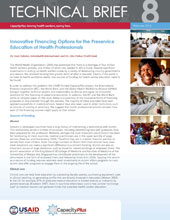
New Publication Spotlight: Innovative Financing Options for the Preservice Education of Health Professionals
Many developing countries are making significant investments to increase the number of health workers available to provide care to growing populations. However, the available funding is far short of what is required. For these countries to train and produce a health workforce sufficient to meet the populations’ needs, new sources of funding for health worker education need to be found.
To address this problem, CapacityPlus partnered with the International Finance Corporation, the World Bank, and the Global Health Workforce Alliance in an exploration of innovative solutions for the financing of health worker education. A new CapacityPlus technical brief, Innovative Financing Options for the Preservice Education of Health Professionals, presents a summary of the forms of financing proposed or documented through this process.
Funding sources for schools to consider
In this concise brief, CapacityPlus’s Dr. Kate Tulenko and the World Bank’s Dr. Alex Preker describe 19 forms of financing, the majority of which have been applied successfully in medical schools:
 Alumni
Alumni- Clinical care
- Concessionary lending
- Diaspora
- Diverting existing financial streams
- Donations and endowments
- Gifts-in-kind
- Health insurance funds
- Local development funds
- Matching funds
- Microdonations
- Private for-profit investors
- Private foundations
- Religious communities and institutions
- Research funding
- Scholarships
- Student loans
- Tiered admission
- Tuition
Several of these forms of financing have also been used in other institutions, such as schools of nursing or pharmacy. The authors provide country-based examples and suggest that health professional schools consider how each of the financing sources might apply to their school.
An example from Ghana
One form of financing is diverting existing financial streams in new ways. Instead of spending large sums to train health workers overseas, for example, countries could direct their limited funds more effectively by founding health professional schools in-country. In Ghana, $500,000 per year was directed toward scholarships for training dentists in the UK. Only 10% of these trainees returned to Ghana. Therefore, the government opted to divert this particular funding stream into founding the country’s first dental school. Started with an investment of $750,000, the school has now trained 200 dentists, and the majority of these are practicing in Ghana.
Learn more
To learn more, read the technical brief—available as an interactive version and a PDF. And please let us know what you think; we welcome your feedback.
Related items:


